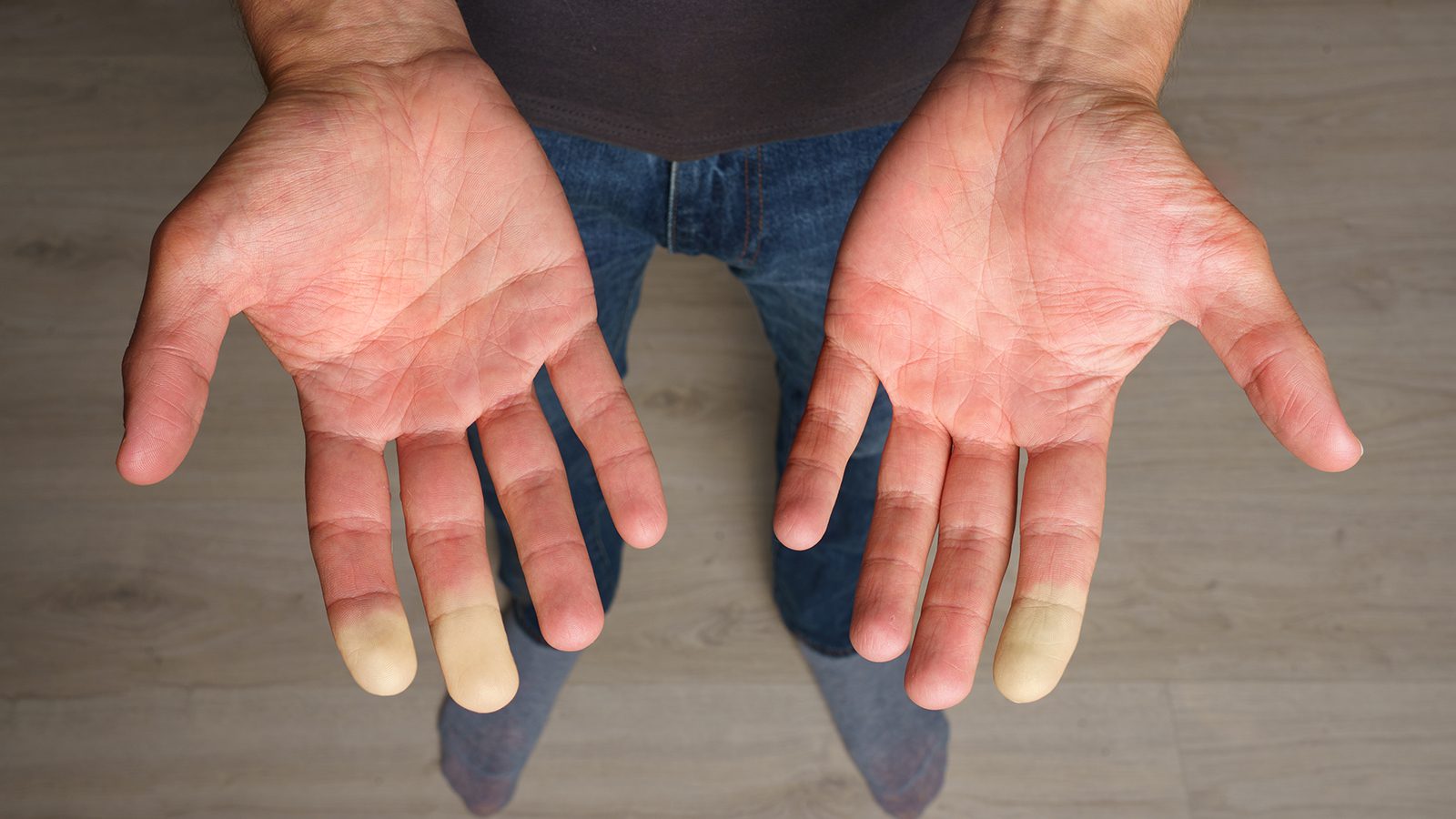Raynaud’s disease, or Raynaud’s phenomenon, causes blood vessels in your extremities to become narrow. This disease restricts the blood flow to your fingers and toes. These attacks occur when from exposure to emotional stress or cold weather. This misunderstood condition can be controlled with lifestyle changes. However, it can become severe, causing skin sores that lead to gangrene. Here are five signs of Raynaud’s disease and how to manage it.
Two types of Raynaud’s phenomenon
There are two types of this Raynaud’s disease-primary and secondary.
Primary: This is the most common form of this condition. It’s unknown what causes primary Raynaud’s disease, but it’s not because of a medical condition. For example, you may first notice discoloration of your fingers or toes when you’re out cold.
Secondary: This is a more severe form of this disease due to an underlying illness or other factors. Raynaud’s occurs in people with these conditions:
- Lupus
- Rheumatoid arthritis
- Carpal tunnel syndrome
- Atherosclerosis
- Sjogren’s syndrome
- Buerger disease
- Thyroid disorders
- Crest syndrome
- Polymyositis
- Blood disorders
- Pulmonary hypertension
These diseases damage your blood vessels and arteries, putting you at risk for Raynaud’s disease.
Who is most likely to get Raynaud’s disease?
Anyone can get this disease, but some groups are more likely to get it. Those people most at risk include the following:
- Women are nine times more apt to get this disease than men
- It often shows up in teens, usually around fifteen
- Family history of Raynaud’s disease makes you more likely to get it
- People who work with vibrating machines like jackhammers, gasoline chain saws, power hand tools, or pneumatic hammers
- Individuals taking certain medications like beta blockers
- People exposed to chemicals
- Autoimmune diseases
- Trauma or injury
- Cigarette smokers
5 Signs of Raynaud’s Disease and How to Manage It
Watch for these red flags that can reveal this syndrome.
1. Pale white extremities that turn bluish-purple
The first indication that you have this condition is that your hands or toes turn a pale white when exposed to cold or stress. You’ll notice how the tips of your fingers are extremely pale, but there’s a line below where your skin is a typical color. People may mention it to you because it’s very noticeable. The skin of the affected parts of your body turns white because the blood flow is restricted.
2. Bluish-purple coloration
Once your extremities start warming up, they’ll turn blueish purple. This symptom happens because as the constricted blood vessels relax, the blood starts flowing again. Even though the blood is flowing in, there’s not enough oxygen, so your fingertips and toes turn blue.
Some people notice other parts of their body have this discoloration when exposed to the cold. Regions of your body that can be affected by Raynaud’s disease include:
- Ears
- Nose
- Lips
- Nipples
3. Red, swollen extremities
As these areas finally warm up and your circulation improves, your extremities will turn red. They may swell, turn bright red, throb, or burn.
4. Throbbing or burning pain
As the blood flows back into your extremities, your fingers and toes go from white to blue to bright red. It’s an excruciating sensation. Many people describe it as pins and needles feeling. It can be challenging to move your fingers or toes when this happens. Raynaud’s disease is a potentially debilitating condition. These attacks may last for minutes to hours.
5. Skin ulcers
In severe cases of Raynaud’s disease, the lack of blood flow may cause tissue sores, skin infections, or skin ulcers. Left untreated, these are hard to treat and can develop into gangrene. Fornaturely, skin ulcers occur only in extremely severe cases of Raynaud’s disease.
What causes Raynaud’s disease?
Scientists aren’t sure what causes this disease. It’s more common in young people aged fifteen to early twenties. Women get it more often than men. It’s also a common side effect of certain vascular diseases for people who work with vibrating machinery or take certain medications. Stress and emotional factors also trigger episodes of Raynaud’s. First, being out in the cold causes your extremities to turn white and blue. Your blood vessels constrict. As the blood flows, because the blood lacks oxygen, the affected areas turn bluish-purple. The last part of an episode happens as blood flows free, causing sudden burning and throbbing pain in the regions.
Why is it a misunderstood disease?
If you find that holding a cold drink or grabbing meat from the freezer department at the grocery stores turns your fingers white and then blue, you may have Raynaud’s disease. Some people think you’re just super sensitive to the cold, but according to the Raynaud’s Association, approximately 15 to 30 million people suffer from this phenomenon. It’s a painful disease that may interrupt your life, job, or home life.
Of course, winter is usually the year Raynaud’s disease flares up, but air conditioning can also trigger it. If your fingers or toes get painful and your experience discoloration, you may have Raynaud’s disease.
How is Raynaud’s disease diagnosed?
Determining if you have primary or secondary Raynaud’s disease is essential. Some tests can decide which one you have.
- Nailfold capilaroscopy: During this test, your doctor will look at your skin under the base of your fingernail under a microscope. It shows any deformities or swelling of the blood vessels in this area.
- Antinuclear antibodies test: If you test positive, you may have an overactive immune system. Think of autoimmune or connective tissue diseases.
- Erythrocyte sedimentation rate: This test determines how fast your red blood cells settle to the bottom of a test tube. The quicker they settle, the more likely you will have an autoimmune or inflammatory disease.
None of these tests can one-hundred percent diagnose Raynaud’s. Most people have primary Raynaud’s. Few will have secondary, only one person in every 100 people.
Can you treat Raynaud’s disease with lifestyle changes?
Prevention is the fundamental way to treat this disease. However, you may need to incorporate lifestyle changes to help yourself cope. Lifestyle changes include:
- Stay out of the cold as much as possible: Try to avoid cold weather, and bundle up when you need to be outside.
- Wear proper clothing: Wear scarves, sweaters, or insulated gloves when out in the cold. Keeping your entire body warm (even your head!) will help keep your blood vessels from constricting and stopping the blood flow to your extremities. In addition, there are fingerless gloves to wear inside and gloves powered by a USB cable for typing.
- Cut an episode short: You can stop an attack by waving your arms to get your blood flowing or running your hands under warm water to warm them.
- Reusable warming packets: Hunters, sports fans, and runners use hand-warming packets. These work great for preventing an attack of Reynaud’s disease.
- Avoid nicotine: Besides cold weather, smoking nicotine triggers this disease. Therefore, if you have this disease, you must cut back and eventually stop smoking and tobacco chewing.
- Reduce your stress: Raynaud’s disease may also come from extreme emotions like fear, excitement, and anger. Find ways to reduce your stress,s such as relaxation techniques.
- Protect your feet and hands from injury: Injuries put you at risk for Raynaud’s disease. Wear shoes outside to protect your feet.
- Exercise: Exercise improves your circulation. Keep a regular exercise routine to decrease the number of episodes.
- Take a warm bath: Take a bath or soak your feet in a bowl of warm water during an episode.
What are some other treatments for Raynaud’s disease?
Secondary Raynaud’s disease usually requires more than lifestyle changes. Due to the severity of this disease, mediation to prevent or control the attacks may be necessary. Some drugs also help dilate blood vessels to reduce the risks of the disease. Clinical trials hope to find the best treatment for individuals suffering from secondary Raynaud’s disease. Left untreated, this form of the disease leads to skin infection, gangrene, and sometimes death.
Chiropractic care
Chiropractors say that Raynaud’s disease is the overstimulation of the nervous system. The disease constricts the blood flow to blood vessels and results in disease symptoms. Your chiropractor can adjust the misalignment in your spine to improve your circulation. These adjustments can also help reduce your stress which helps decrease the number the episodes.
Biofeedback
Biofeedback is a mind and body technique. It teaches you to your mind to control your body temperature and control the constriction of your blood vessels. It’s thought that these techniques can help reduce the severity and number of attacks. It also uses guided imagery to increase the temperature of your feet and hands. The sessions also work on deep breathing and relaxation exercises.
Final thoughts on Raynaud’s disease and taking care of yourself
Raynaud’s disease occurs when exposed to the cold, causing your blood vessels to constrict. Because the blood can’t reach your fingertips, toes, nose, and ears, they turn white. When the blood vessels open again, the lack of enough oxygen in your blood makes your extremities turn blueish-purple. The episode ends with these areas changing to red from the excess blood flow and extreme pain and burning. Lifestyle changes can help elevate these attacks, such as lowering your stress, stopping smoking, or learning to dress warmly when outside in the cold. If you think you may have Raynaud’s, try some of these suggestions to see if it helps reduce the episodes and bring you some relief.

















 Community
Community

